|
Keeping Cool Victorian Style
by Bob Brooke
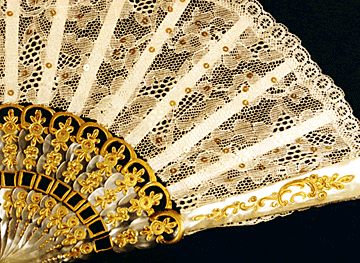 Scarlett
O'Hara, the heroine of Gone With the Wind, armed herself with a magical
tool that she hoped would win the heart of Ashley Wilkes. In her hand
she held the ultimate weapon in the art of love, the tool that allowed
her to signal, to hide, to flirt. That weapon was, of course, the fan. Scarlett
O'Hara, the heroine of Gone With the Wind, armed herself with a magical
tool that she hoped would win the heart of Ashley Wilkes. In her hand
she held the ultimate weapon in the art of love, the tool that allowed
her to signal, to hide, to flirt. That weapon was, of course, the fan.
The Greeks, Romans and Etruscans all used them, both for cooling off and
for ceremonies. In Egypt, Nubian slaves fanned the pharaoh with large
paddle-shaped fans made of ostrich feathers as he say on his throne as
early as 3,000 B.C.E.
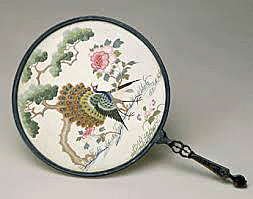 The
origin of hand fans can be traced as far back as 4,000 years ago in
Egypt. The fan was seen as a sacred instrument and used in religious
ceremonies and was also seen as a symbol of power royalty even in this
early form, as evidenced by the two elaborate fans found in King Tut's
tomb. One of the fans had a golden handle and was covered in ostrich
feathers while the other was ebony overlaid with gold and precious
stones. Other ancient peoples such as the Hebrews, Persians, Greeks, and
Romans also used hand fans in various forms. The
origin of hand fans can be traced as far back as 4,000 years ago in
Egypt. The fan was seen as a sacred instrument and used in religious
ceremonies and was also seen as a symbol of power royalty even in this
early form, as evidenced by the two elaborate fans found in King Tut's
tomb. One of the fans had a golden handle and was covered in ostrich
feathers while the other was ebony overlaid with gold and precious
stones. Other ancient peoples such as the Hebrews, Persians, Greeks, and
Romans also used hand fans in various forms.
The First Folding Fans
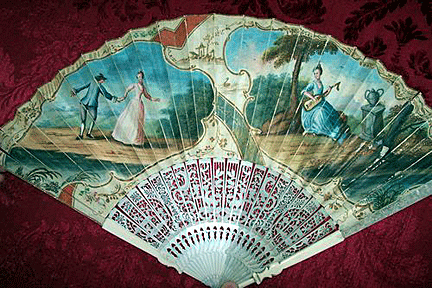 The
first folding fans arrived in Europe some time during the16th century,
thanks to merchant traders and returning missionaries who had been to
China and Japan. These early fans were expensive and considered status
symbols reserved for the nobility. Early fan makers produced sticks and
guards from ivory, mother-of-pearl, and tortoiseshell, of often carving
or piercing them, and embellishing them with gold, silver and precious
stones. They also employed skilled artisans who hand-painted the bodies
of the fans, or leaves. . It wasn’t until the 18th century that fans
became important fashion accessories for all classes: The
first folding fans arrived in Europe some time during the16th century,
thanks to merchant traders and returning missionaries who had been to
China and Japan. These early fans were expensive and considered status
symbols reserved for the nobility. Early fan makers produced sticks and
guards from ivory, mother-of-pearl, and tortoiseshell, of often carving
or piercing them, and embellishing them with gold, silver and precious
stones. They also employed skilled artisans who hand-painted the bodies
of the fans, or leaves. . It wasn’t until the 18th century that fans
became important fashion accessories for all classes:
While the original purpose of hand fans was to create a breeze, people
also used them
for protection from the rain, as a tray for offering or receiving
refreshments, for salutations, signals, to punctuate sentences, and to
hide bad teeth. Fans have also played a role in the Christian Church.
European women used them to hide their faces during mass, and from about
300 A.D. until about 1300, they used fans to brush flies from sacred
vessels in churches.
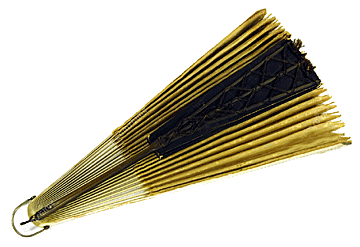 People
also used fans as menus, theater programs, and dance programs: serving a
double purpose as a fan and a dance card. These dance fans had a large
hook that fastened over the ladies’ sashes and a pencil attached to the
handle. People
also used fans as menus, theater programs, and dance programs: serving a
double purpose as a fan and a dance card. These dance fans had a large
hook that fastened over the ladies’ sashes and a pencil attached to the
handle.
Marco Polo was the first European explorer to return to home with fans.
By the 16th century, sophisticated Italian women began using fans which
soon became de rigeur throughout Europe. As primarily female fashion
statements, the styles of fans changed to complement the ever- changing
fashions. Their popularity led to experimentation in their production
and merchandising. They often contained concealed mirrors, toiletries,
amusing articulated scenes, even weapons. They became the ideal vehicles
for advertising. Americans could keep pace with events of the French
Revolution by reading the songs and 'slogans printed on fans. A century
later, a farmer could learn the benefits of threshing machines. In 1898,
American voters kept track of the date with a McKinley fan/calendar.
Though Marco Polo brought as assortment of Chinese fans, made of vellum,
paper, swan skin with blades of gold, silver, and inlaid
mother-of-pearl, to Europe, it was the Japanese who invented the folding
fan.
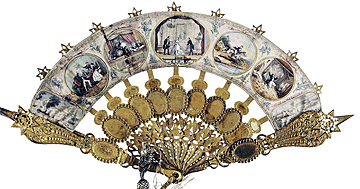 By
the 18th century, the folding fan came into common use in Paris. The
blades could be of carved ivory or tortoise shell mounted with precious
inlaid metals and elaborate jewels. These rococo fans certainly were the
finest ever made. Less expensive fan sticks were usually of sandalwood
or fruitwood. During this period, fan painting took on a form of
stylized art, perhaps painted' by Watteau or Fragonard. By
the 18th century, the folding fan came into common use in Paris. The
blades could be of carved ivory or tortoise shell mounted with precious
inlaid metals and elaborate jewels. These rococo fans certainly were the
finest ever made. Less expensive fan sticks were usually of sandalwood
or fruitwood. During this period, fan painting took on a form of
stylized art, perhaps painted' by Watteau or Fragonard.
 The
19th century saw the greatest production of fans to date. The earliest
ones made here were paper souvenir fans depicting historical scenes as
well as current events. Lithographers portrayed views of New York's
Crystal Palace in 1853, the Philadelphia Centennial in 1876, printed in
black on a cream background, and the World's Columbian Exposition in
1893. The
19th century saw the greatest production of fans to date. The earliest
ones made here were paper souvenir fans depicting historical scenes as
well as current events. Lithographers portrayed views of New York's
Crystal Palace in 1853, the Philadelphia Centennial in 1876, printed in
black on a cream background, and the World's Columbian Exposition in
1893.
By 1866, there was a great American fan factory near Quincy,
Massachusetts. The owner's name was E.S. Hunt, and in 1868 he patented
the process which included folding or creasing and gluing the leaf to
the fan sticks at the same time under pressure. This had never been done
before in either Europe or America and gave the Hunt factory a boost on
the competition until the factory closed in 1910.
By the late 19th century. every department store and every manufacturer
advertised on fans—coffee, milk, bread, carpet sweepers, restaurants,
cafes, theaters, ice bates, sewing machines, etc. All of the above
appeared at one time or another on a fan.
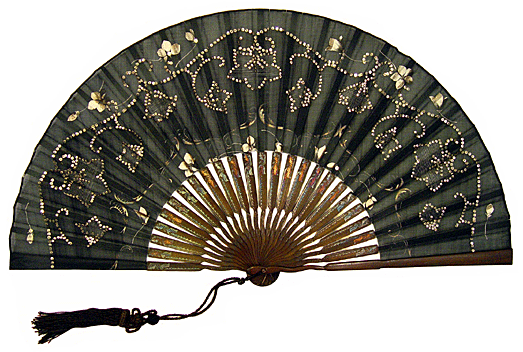
Before the advent of air-conditioning,
the mourning fan was an absolute necessity at funerals. Fan makers often
fashioned these from black materials to coincide with the black clothing
worn during recognized periods of mourning. Funeral directors printed
their name and address on the guards of a cheap wood fan which they gave
to mourners, giving them relief from the heat while promoting their
services.
In the early 20th century fans became a way to advertise and promote
restaurants, hotels, shops, ships, politicians, and even funeral
parlors. During the same time, women stopped using fans as a fashion
accessory because they considered a nuisance to carry, and by the 1930s,
they had all but disappeared.
Collecting Fans
Fan collectors often specialize. Some concentrate on a particular era,
such as the early18th century. Others might specialize in a subject. For
example, a collector fond of transportation seeks fans. ranging from
those depicting the Montgolfier brothers' first balloon flight in 1783
to modem cruise' and airline souvenir fans. An adverts ing specialist
might concentrate on fans produced for political candidates, those
purchased as mementoes of early world's fairs and expositions, or ones
manufactured to pro-mote specific product categories, such as beverages.
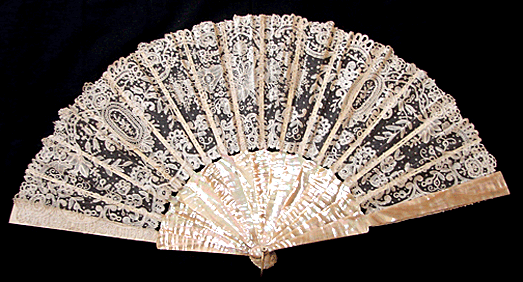
As with any collectible, condition is of prime importance. For this
reason, few collectors purchase a framed fan unless it’s rare. As a fan
is properly unfolded from left to right, it "staircases"—each stick
rests atop the one to its left. A collector frames a fan only if it’s
fragile, and closing it would cause further damage.
The Market for Fans
Surprisingly, a fan that depicts a historical event will hold its value
"even if' there are some minor tears or breaks." She defined "historical
events" as "great exhibitions, proclamations, battles, coronations, or
the birthday or marriage of royalty, nobility or a world leader."
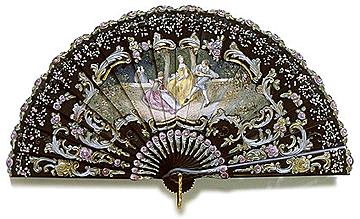 After
the historical connection, the sticks and guards are an important factor
in determining value. Ivory and mother-of-pearl are the most valuable
and handmade lace leaves bring good prices. After
the historical connection, the sticks and guards are an important factor
in determining value. Ivory and mother-of-pearl are the most valuable
and handmade lace leaves bring good prices.
Mint condition fans and fans with their original boxes are rare. Other
fans that command high prices are those with spangles or sequins, French
fans with highly decorated mother-of-pearl sticks, fans by the premier
maker, Duvellory, and American advertising fans with good graphics.
Avoid fans that need much repair. The decoration should be symmetrical.
Asymmetry.
is often the result of a repair made to the fan by gluing two sticks
together, which results in an off-center image on the fan. Avoid stained
or torn fans.
The prices of folding fans show a similar diversity. Many of those found
on the market are typical, mass produced late Victorian fans. One common
type is a wood brise, made solely of wood sticks strung together by a
ribbon. Often given as a memento of a dance or supper party, this fan
was often autographed by a woman's friends and escort. A "freebie" of
its time, this fan today fetches $25 to $80.

Oriental fans are also collectible.
Mandarin or thousand faces fans. have silk leaves depicting Chinese
court scenes. The people's clothes are appliqued silk, and their faces
are small ivory ovals. Made strictly for export, these fans may have
sticks made of wood, bone, ivory, cinnabar, lacquer filigree, or may
have combination of any o these. Prices may start at $140 for a fan with
21 faces; one with 100 tiny faces may range from $1000 to $5000.
Fans used to signal troops in battle and those concealing daggers are
also highly sought and correspondingly expensive, attracting not only
fan collectors, but weapons buffs.
<
Back to More Antique Spotlights
Next Article > |
